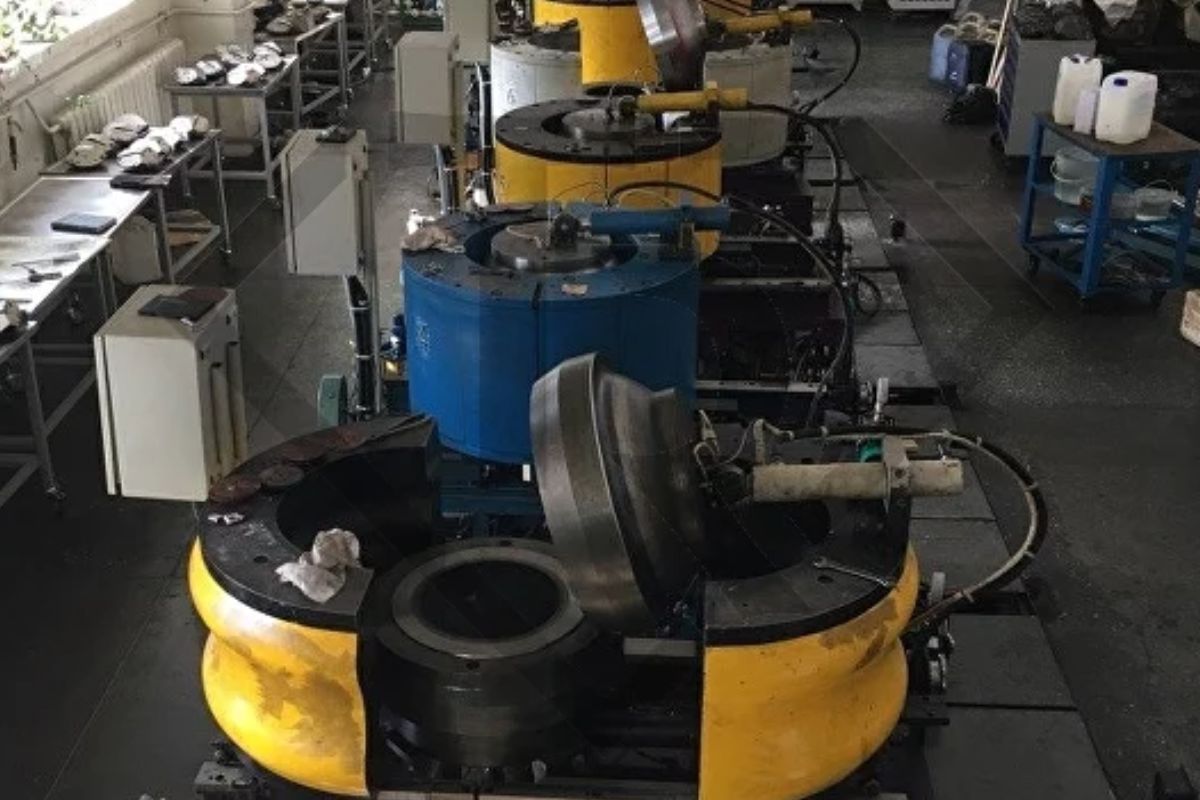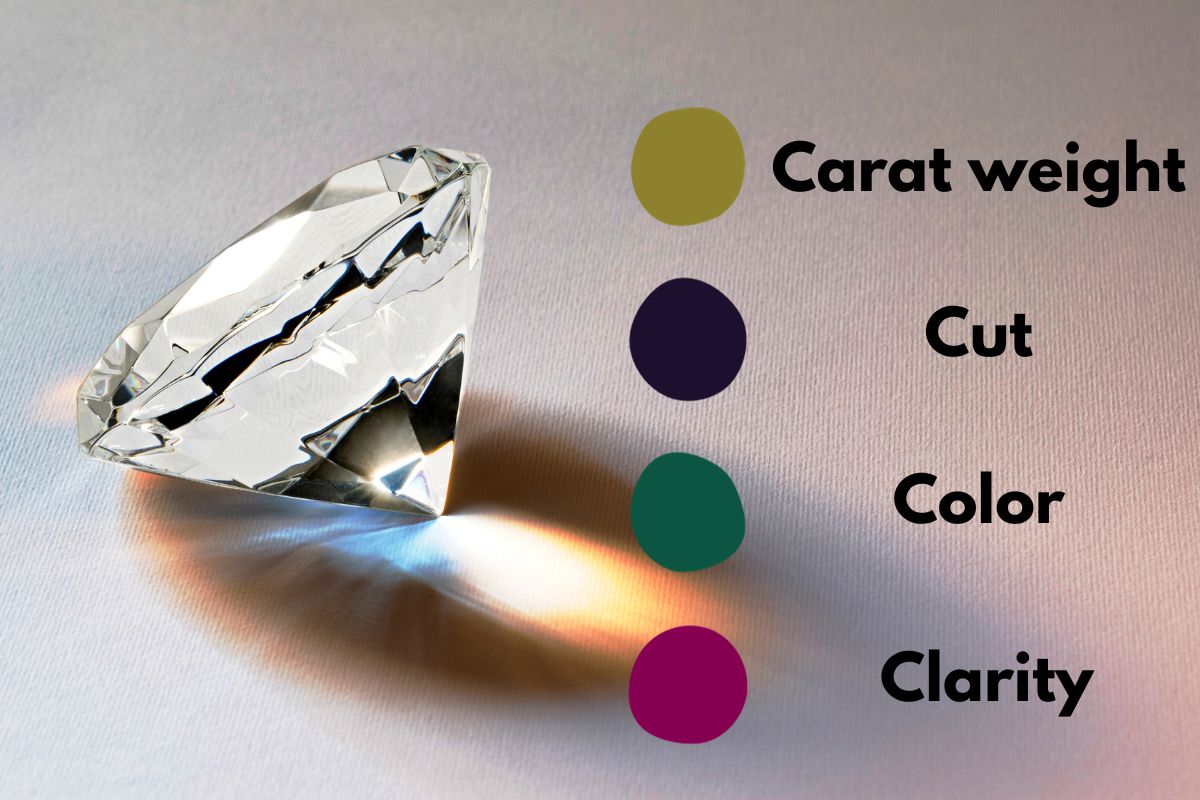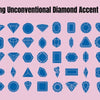
How Diamonds Are Made: Unveiling the Natural Formation Process
Diamonds, often coveted for their unmatched hardness and captivating brilliance, are formed deep within the Earth's mantle. You might imagine these shimmering stones beginning their journey more than one hundred miles beneath the planet's surface. Here, extreme conditions—pressures exceeding 725,000 pounds per square inch and temperatures soaring above 2,000 degrees Fahrenheit—trigger the transformation of carbon atoms into the crystalline structures that manifest as diamonds.
Over the course of millions or even billions of years, volcanic activity can then transport these stones closer to the Earth's surface. During their ascent, the magma cools to form kimberlite or lamproite pipes, the primary sources of mined diamonds. It is within these pipes that diamonds are found, patiently waiting to be discovered.
Table Of Contents
- The Formation of Natural Diamonds
- Types of Natural Diamonds
- Diamond Mining and Extraction
- Synthetic Diamonds
- Physical and Chemical Properties of Diamonds
- Diamonds in Jewelry
- Diamonds Beyond Earth
- Diamonds in Science and Industry
- Historical and Cultural Significance
- Diamonds and the Environment
- Conclusion
- Frequently Asked Questions
This extraordinary process means that every natural diamond you encounter is ancient, and each carries a unique story from deep within the Earth. The rarity and the journey that these gemstones undertake contribute to the exceptional value and allure that diamonds hold in our society.
The Formation of Natural Diamonds
Your exploration into the creation of natural diamonds reveals a journey of carbon through extreme environments. You'll discover how elements transform under immense pressure and temperature conditions to become the coveted gems known as diamonds.
Carbon and its Journey
Carbon, the elemental building block for diamonds, undergoes profound changes deep within the Earth's mantle. It's here that carbon atoms are subjected to intense pressure, sometimes over 50 kilobars (kb), and high temperature, typically above 1,000 degrees Celsius. This journey begins far beneath the Earth's surface, often hundreds of kilometers deep.
From Carbon to Diamonds
As carbon is exposed to these extreme conditions, it begins to crystallize, forming diamonds. This transformation occurs over millions or even billions of years. During this time, carbon atoms bond in a specific way that results in the hardest known natural material on Earth.
Geological Conditions Required
Diamond formation requires very specific geological conditions:
- Pressure: At least 45-60 kilobars.
- Temperature: Approximately 1,000-1,300 degrees Celsius.
These conditions are typically found in the Earth's upper mantle, at depths between 140 to 190 kilometers. Geologists refer to these areas as "diamond stability zones," where the environment is just right for diamond creation.
Locations of Diamond Formation
Diamonds are formed in areas known as subduction zones or in the mantle beneath stable continental plates. Once formed, some diamonds are brought closer to the Earth’s surface through volcanic eruptions that form kimberlite or lamproite pipes. These pipes are volcanic conduits made of kimberlite rock, which is a primary source of natural diamonds. Your understanding of these volcanic pipes as vertical structures is crucial because they act like elevators bringing diamonds within reach.
Through this journey from carbon to the cherished diamond, the transformation entails more than just a change in atomic structure; it is a testament to the dynamic and powerful forces at play deep within our planet.
Types of Natural Diamonds

Natural diamonds, the hardest known mineral, are cherished gemstones with characteristics that vary depending on their geographical origins and formation conditions. You'll discover they fall into distinct categories, have a range of color variations, and originate from various global locations.
Diamond Categories
Natural diamonds are primarily categorized by the presence of nitrogen and can be divided into Type I and Type II:
-
Type I: These diamonds contain nitrogen atoms that can alter their physical properties. They are subdivided into:
- Type I a: Contain aggregated nitrogen atoms and constitute most natural diamonds.
-
Type II a: They are less common and lack aggregated nitrogen.
-
Type II: These diamonds have no detectable nitrogen impurities. There are two subtypes:
- Type II a: These are chemically pure and often exhibit exceptional optical clarity.
- Type II b: Contain traces of boron, which can give the diamond a blue or grey color.
Color Variations
Natural diamonds exhibit a wide spectrum of colors due to various impurities and structural phenomena:
- Colorless: These are the most iconic and are valued for their lack of color, graded on a D (no hue) to Z (light yellow) scale.
- Fancy Colors: Colors range from yellow and brown, which are relatively common, to rarer hues like pink, blue, green, orange, and red. The intensity of these colors can vary from faint to vivid.
Geographical Sources
Natural diamonds are mined across different regions, each imparting unique characteristics to the gemstones:
- Africa: Nations such as Botswana, South Africa, the Democratic Republic of the Congo, Angola, and Namibia are renowned for their rich diamond deposits.
- Russia: Known for producing high-quality gems, including rare Type IIa diamonds.
- Australia: Responsible for a large percentage of the world's colored diamonds, especially pinks and reds.
- Canada: Emerging as a significant source of ethical and high-quality gemstones.
- Brazil and India: These countries contribute to the diamond supply, with Brazil known for fancy colored diamonds and India for its historical diamond mines.
Diamond Mining and Extraction

When you’re talking about diamond mining and extraction, you're looking at a process that retrieves these precious stones from deep within the earth as well as from riverbeds and ocean floors. The primary mining methods involve extracting diamonds from kimberlite and lamproite pipes, as well as from alluvial deposits where they've been carried by natural erosion.
Mining Methods
Your understanding of diamond extraction heavily relies on the mining methods employed. There are two main types of mining operations: open pit and underground. Open-pit mining involves the removal of large quantities of earth to reach the diamonds below. This method is basically "strip mining" for diamonds. On the other hand, underground mining involves creating tunnels and shafts to access deep deposits of diamonds. Block caving, a technique where a large section of rock is mined, is often used in this context.
Kimberlite and Lamproite Pipes
Kimberlite and lamproite pipes are the primary sources of natural diamonds. A kimberlite pipe is a volcanic pipe formed by the deepest forms of volcanic activity, where magma from the mantle carries diamonds to the surface. Conversely, lamproite pipes are less common, but can also bring diamond deposits up from the depths of the Earth. These pipes form carrot-shaped deposits, and the excavation of these is a major undertaking requiring substantial investment and technical expertise.
Alluvial Deposits
Alluvial deposits refer to diamonds that have been transported from their original location in kimberlite or lamproite pipes by natural geological processes. Over millions of years, rivers and streams can erode these primary sources and carry diamonds to sediment beds in rivers, streams, and along coastlines. Alluvial mining involves the recovery of these diamonds from such sediments. This typically involves sifting through the sand, mud, and gravel to extract the gems.
| Characteristic | Synthetic Diamonds | Natural Diamonds |
|---|---|---|
| Formation | Created in a controlled laboratory environment using technological processes. | Naturally formed deep within the Earth over millions of years. |
| Cost | Generally more affordable than natural diamonds. | Varies based on cut, carat, color, and clarity; generally perceived as more valuable. |
| Quality | Can have fewer inclusions and may be of consistent quality. | Natural variations in quality; may have inclusions. |
| Environmental Impact | May have a lower environmental impact compared to mining. | Mined diamonds have environmental considerations. |
| Certification | Certified as lab-grown diamonds. | Certified based on natural origin. |
| Market Acceptance | Gaining acceptance in the market. | Traditional and widely accepted. |
Synthetic Diamonds
When you're looking at diamonds, it's important to understand that synthetic diamonds are real diamonds created using technological processes that mimic the natural diamond growth under the Earth's crust. They are identical to naturally occurring diamonds in terms of their physical, chemical, and optical properties.
HPHT Method

The High Pressure High Temperature (HPHT) method replicates the natural diamond-making conditions by exposing carbon to high pressure and high temperature. Your synthetic diamond originates from a diamond seed placed in carbon, which is then subjected to temperatures over 1400°C and pressures above 5 GPa. The process transforms carbon into a lab grown diamond, typically used for industrial purposes due to their hardness and thermal conductivity.
CVD Method

Chemical Vapor Deposition (CVD) is another technique to create synthetic diamonds where you initiate the process by placing a diamond seed in a chamber. Gas, rich in carbon like methane, is introduced, and when energy is applied, it triggers the release of carbon atoms that deposit on the diamond seed, gradually building up a synthetic diamond, layer by layer. CVD diamonds can possess qualities similar to high-grade natural gems and are sought after in both jewelry and industrial applications.
Applications of Synthetic Diamonds
Synthetic diamonds serve a variety of industrial applications due to their unique properties. They are used in cutting, grinding, and drilling tools where extreme hardness is required. Nanodiamonds, a byproduct of the detonation process, have found utility in electronics and manufacturing. Beyond industrial uses, synthetic diamonds, also known as lab grown diamonds, have become increasingly popular in the gemstone market as they offer ethical and less costly alternatives to natural diamonds.
Physical and Chemical Properties of Diamonds
| Property | Description |
|---|---|
| Hardness | Hardest known natural material; rated 10 on the Mohs scale. |
| Density | Average density of 3.52 g/cm³. |
| Melting Point | Approximately 3,500°C (6,332°F) under high pressure. |
| Crystal System | Cubic crystal system; typically octahedral or dodecahedral shapes. |
| Refractive Index | 2.42 (high refractive index contributing to brilliance). |
| Dispersion | High dispersion, creating the play of colors (fire) in diamonds. |
| Chemical Formula | Carbon (C) |
| Bond Type | Each carbon atom is tetrahedrally bonded to four other carbon atoms. |
| Electrical Conductivity | Insulator of electricity due to its strong covalent bonds. |
| Thermal Conductivity | Excellent thermal conductivity. |
The properties of diamonds are a testament to their unique makeup and creation. Your understanding of these remarkable gems is rooted in the arrangement and strength of carbon atoms forming their crystal structure.
Hardness and Durability
Diamonds are renowned for their hardness, which is the highest of any natural material on the Mohs scale. This impressive hardness is due to a strong covalent bond between carbon atoms in a repeating lattice. Because of this, diamonds resist scratches and abrasion better than any other gemstone, giving them unparalleled durability.
- Carbon Atoms: Tightly packed in a dense, three-dimensional network.
- Bond Strength: Each atom forms a robust covalent bond with four other carbon atoms.
- Crystal Structure: The arrangement bestows hardness that makes diamonds ideal for cutting tools and abrasion-resistant applications.
Optical Properties
Your diamond's brilliance and the way it plays with light are outcomes of its optical properties. The gem's high refractive index and dispersion cause light to bend and spread, producing the characteristic sparkle.
- Refractive Index: Determines the diamond's ability to bend and refract light.
- Dispersion: Refers to the diamond's ability to split white light into its component colors.
- Brilliance: The total amount of light reflected from the inside and surface of the diamond.
Diamonds in Jewelry
When you consider diamonds in jewelry, it’s essential to understand the meticulous craftsmanship behind each stone and how it impacts the overall appeal and value of the piece.
Cutting and Polishing Diamonds
The transition of diamonds from rough stones to dazzling jewels happens through cutting and polishing, a process where skill and precision are paramount. Experienced artisans known as diamond cutters shape each diamond to maximize its brilliance, fire, and scintillation. They must consider the diamond’s natural characteristics to decide on the shape and number of facets.
The Four Cs

As your search for the perfect diamond jewelry begins, you'll encounter the universal standard for assessing diamond quality — The Four Cs:
- Carat Weight: Measures the diamond’s weight, with one carat equivalent to 200 milligrams.
- Clarity: Indicates the presence of inclusions or blemishes, graded from Flawless (FL) to Included (I).
- Color: Evaluated on a scale from D (colorless) to Z (light yellow or brown), with colorless diamonds being the most sought-after.
- Cut: Not to be confused with shape, this refers to how effectively the diamond interacts with light, graded from Excellent to Poor.
The Gemological Institute of America (GIA) is a trusted source that certifies diamonds based on these criteria, providing assurance of their quality.
Jewelry and Engagement Rings
In the realm of jewelry, diamonds are often the centerpiece, especially in engagement rings. A jewelry store can provide a multitude of styles, from classic solitaires that emphasize the diamond's cut and clarity to intricate vintage settings that reflect light to accentuate color and carat size. The bonding of diamonds into a piece of jewelry magnifies their allure, making them timeless symbols of elegance and commitment.
Diamonds Beyond Earth
Exploring the cosmos reveals that Earth is not the only place where diamonds can form. Your celestial journey will uncover diamonds in meteorites and the possibility of diamond rain on planets like Neptune and Uranus.
Extraterrestrial Diamonds
When you consider meteorites, you're looking at some of the oldest diamonds available for study. These space diamonds are not a rarity; they've been discovered within the fragments of asteroids that crash-land on Earth. The process that forms them is linked to high-pressure phenomena, including asteroid impact events. As space debris collides, the intense heat and pressure can compress carbon-rich areas into tiny diamonds.
Theoretical Formation in Outer Space
Venture beyond the asteroid impacts, and you find intriguing theories about diamonds in the far reaches of space. Envision gas giants like Neptune and Uranus, with atmospheric conditions so extreme that carbon can crystallize into diamond rain. While these remains of carbon are theorized and not directly observed, your understanding of cosmic chemistry suggests such phenomena within the dense atmospheres of these distant worlds. Magnificent as it may sound, these space gems highlight the vast potential for diamond formation across the expanse of the universe.
Diamonds in Science and Industry

Diamonds, revered for their unmatched hardness and thermal conductivity, have applications beyond just their sparkle. They serve crucial roles in both scientific endeavors and heavy-duty industrial operations.
Scientific Uses
In the scientific realm, diamonds are invaluable tools. Your experience with high-precision instruments may often involve diamond components. For example, diamonds are used in high-pressure experiments due to their resilience. The Gemological Institute of America (GIA) utilizes diamonds’ unique properties to develop cutting-edge tools for gemstone analysis, ensuring that you receive precise information about gemstone quality.
Industrial Cutting and Drilling
When you encounter diamond-tipped tools, you're witnessing industrial diamonds in action. These diamonds are not fit for jewelry but are excellent for cutting and drilling. Industrial diamonds provide the hardness necessary to craft tools that can cut through almost any material. In construction or mining, diamond drills are essential for your needs; they can create precise holes in hard surfaces, dramatically improving efficiency and safety on the job site.
Historical and Cultural Significance

Diamonds, composed of carbon, are much more than mere adornments; they are historical artifacts that offer a window into the cultural tapestry of our past. Your understanding of diamonds must encompass their journey from deep within the Earth to their esteemed place in human history.
Early Discoveries
Diamond discovery dates back to ancient India, where diamonds were first mined. Recognized for their hardness and brilliance, these precious stones quickly became highly prized. In these early days, you would find diamonds only in the alluvial deposits of rivers in India, making them infinitely rare. Pliny the Elder, a Roman naturalist, documented diamonds, giving you one of the earliest written accounts of these gems. Their rarity and the difficulty involved in mining them only added to their allure and significance across various cultures.
Diamonds in Literature and Myth
Throughout literature and myth, diamonds have been synonymous with invincibility and power. Often found at the center of legendary tales, they frequently symbolize the eternal and the pure. You'll notice that many cultures revered diamonds for their supposed magical properties—protection from evil, cure for ailments, to name a few. It's not uncommon to find references to diamonds in ancient texts, crossing from mere physical beauty to embodying deep symbolic meaning. From adorning the crowns of kings and queens across the Atlantic to inspiring myriad characters in lore, diamonds have always found a way to weave themselves into the narrative of human history.
Diamonds and the Environment

Your understanding of diamonds isn't complete without considering their environmental impact. The journey of a diamond from deep within the Earth to a sparkling gem involves processes that affect the planet.
Impact of Diamond Mining
Diamond mining can have significant environmental consequences. Land degradation and habitat destruction result from open-pit and underground mining. Furthermore, when not managed properly, water systems can be contaminated by runoff and wastewater from mines. For example, pristine ecosystems have been altered in regions with significant diamond recoveries made, as the extraction process can strip away layers of soil and rock.
The Gemological Institute of America (GIA) does not directly regulate mining practices; however, they do provide information on the origin of diamonds, which can raise awareness of the environmental footprint of certain diamonds. In locations like Kimberley, South Africa, where major diamond mining has occurred, concerns about sustainability and ethical practices highlight the need for oversight and regulation.
Sustainable Practices and Certifications
To reduce negative environmental impacts, sustainable practices are essential. The industry is responding with measures such as reduced land-use impact, water conservation, and the protection of local ecosystems. Certifications and standards, like those from the Kimberley Process, aim to ensure that diamonds are conflict-free, which also promotes more responsible mining practices.
Organizations such as the GIA help consumers make informed decisions through grading reports that can include information about a diamond's journey. Seeking out certified diamonds ensures that your gemstone comes from an operation that respects the environment and contributes to sustainable development.
Conclusion
Diamonds have fascinated humanity with their remarkable hardness, captivating brilliance, and enduring value. Natural diamonds formed deep within the Earth’s mantle, subjected to high pressures and temperatures over billions of years. However, advances in technology have enabled the creation of synthetic diamonds that mimic these conditions, thereby producing gem-quality stones in a laboratory setting.
Synthetic Diamonds: These man-made gems are cultivated through two primary processes: High Pressure High Temperature (HPHT) and Chemical Vapor Deposition (CVD). Both methods replicate the environmental conditions needed to transform carbon into crystalline diamonds. They offer an alternative that is often more environmentally conscious and ethical than traditional mining.
- HPHT Diamonds: Mimic the natural formation conditions by applying high pressure and temperature to a carbon source.
- CVD Diamonds: Involve breaking down molecules of a carbon-rich gas into carbon atoms, which then deposit onto a diamond substrate to form a crystal.
Your choice between a natural or synthetic diamond will be influenced by your personal values, preferences, and economic considerations. While natural gems are often prized for their rarity and unique characteristics, synthetic diamonds provide a consistency in clarity and color, and are gaining popularity as a cost-effective and sustainable option.
In purchasing a diamond, whether for jewelry or industrial use, you'll encounter choices regarding the stone's origin. It is crucial to be informed and deliberate in your decision, ensuring that your selection aligns with your ethical standards and aesthetic criteria.
Frequently Asked Questions
In this section, you'll find detailed answers to some common queries regarding the creation, use, and significance of diamonds, offering insights into everything from their geological origins to their various applications across industries.
What is the timeline for a diamond to fully form?
Diamonds take between 1 billion to more than 3 billion years to fully form under the high-pressure, high-temperature conditions that exist deep within the Earth's mantle.
Can diamonds be created from the ashes of deceased individuals?
Yes, diamonds can be synthetically created from the carbon extracted from the ashes of deceased individuals, a process that provides a way of creating a memorable keepsake.
In what ways are diamonds utilized in various industries and applications?
Aside from their renowned role in jewelry, diamonds are used in various industries for cutting, grinding, and drilling due to their unparalleled hardness. They are also important in technology and scientific research, particularly in high-precision instruments.
What is the geological process that leads to diamond formation?
The geological process that leads to diamond formation involves carbon-bearing materials exposed to high pressure of 45 to 60 kilobars and temperatures of about 900 to 1,300 degrees Celsius, typically at depths between 140 to 190 kilometers beneath the Earth's surface.
What methods are employed to shape and polish diamonds into their final forms?
Diamonds are transformed from their rough state into dazzling gemstones through processes such as cleaving, sawing, bruting, and polishing, utilizing advanced techniques and precise equipment to achieve the desired shape and brilliance.
From what mineral do diamonds originate, and how does this contribute to their structure?
Diamonds originate from pure carbon, and their unique cubic crystal structure is the result of carbon atoms being arranged in a variation of the face-centered cubic crystal structure, forming a lattice that contributes to their exceptional hardness and light-reflective properties.
Checkout some of our top collections:
Leave a comment
Please note, comments must be approved before they are published.













